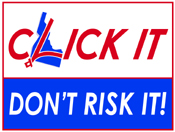
|
CONNECTIONS
|
IDAHO
ITD
HOME
IDAHO DMV
ITD
NEWS
HIGHWAY
SAFETY
IDAHO STATE
POLICE
TRAVEL SERVICES
STATE OF IDAHO
NATIONAL
AASHTO
AAMVA
AAA of IDAHO
FEDERAL HIGHWAYS
FEDERAL AVIATION
IDAHO STATE POLICE
NHTSA
NTSB
TRB
U.S. DOT
Idaho
Transportation
Department
Public Affairs Office
P.O. Box 7129
Boise, ID 83707
208.334.8005
Fax: 208.334.8563
Email

States
with primary seat belt laws post lower
percentage of traffic deaths
Motor vehicle occupants have a 17 percent greater chance of being killed if they are in a crash in a state with a secondary enforcement seat belt law than in a state with a stronger primary enforcement law.
That the National Highway Traffic Safety Administration made assessment recently based on a study of crash fatality data from 2000 to 2004.
 The
study found that the fatality rate per 100 million vehicle miles traveled
(VMT) in states not having primary enforcement laws was 1.21, compared
to 1.03 in states with primary enforcement, or 17 percent higher. The
fatality rate per 100,000 population was 23 percent higher in states
not having primary enforcement laws. Fatality rates were higher for
all age groups in the states not having primary enforcement seat belt
laws.
The
study found that the fatality rate per 100 million vehicle miles traveled
(VMT) in states not having primary enforcement laws was 1.21, compared
to 1.03 in states with primary enforcement, or 17 percent higher. The
fatality rate per 100,000 population was 23 percent higher in states
not having primary enforcement laws. Fatality rates were higher for
all age groups in the states not having primary enforcement seat belt
laws.
"The evidence is clear that the cost of a weak seat belt law is precious lives lost, and often young lives," said Phil Haseltine, Executive Director of the National Safety Council's Air Bag & Seat Belt Safety Campaign.
"Traffic crash injuries and fatalities are an epidemic - we would not let a disease go untreated if we had a cure, and we should not sit by and watch more needless death and injury on our roadways because of weak seat belt laws. It's time for our elected leaders to treat seat belt laws like other traffic laws, enact laws and eliminate crippling secondary enforcement provisions."
The new study adds to the large body of research showing that states with the lowest seat belt use generally have weak secondary laws requiring officers to witness another traffic law violation before stopping someone for not buckling up. Twenty-four states and the District of Columbia have passed primary enforcement laws allowing law enforcement officers to stop and ticket drivers based solely on a seat belt violation.
According to the NHTSA, seat belt use averages 11 percentage-points higher in states that have primary enforcement laws, which cover more than 62 percent of the U.S. population.
The Air Bag & Seat Belt Safety Campaign, a program of the National Safety Council, is a public/private partnership of automotive manufacturers, insurance companies, child safety seat manufacturers, government agencies, health professionals and child health and safety organizations.
The goal of the campaign is to increase the proper use of safety belts and child safety seats and to inform the public about how to maximize the lifesaving capabilities of air bags while minimizing the risks.
Published 3-31-06